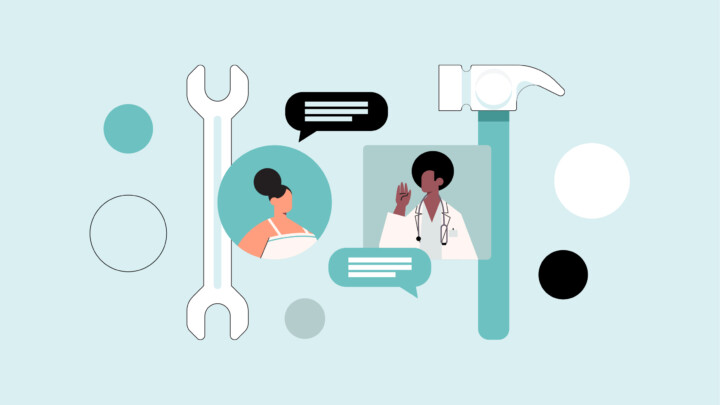
Communicating with patients is an important part of a physician’s job. Excellent patient communication and mutual understanding between a physician and a patient can make all the difference in a patient’s health outcome. Every patient wants to be understood and also wants to understand what his/her doctor is saying about their health and treatment. A survey of Sermo physicians indicates that many physicians get that, but there is much room for improvement. Only 42% of physicians are engaging in active listening, and open-ended questions, thus allowing the patient to be able to properly communicate their concerns. With the power of effective communication, patients can comprehend better their health condition and the treatment options available and make better decisions with their doctor.
Poor doctor-patient communications remains a challenge in many healthcare settings. A lot of patients complain about not feeling understood by their physicians and some also complain of feeling judged, disrespected or dismissed. In a particular study, dissatisfaction with the communication about test results and management plans was a major complaint from patients1.
Considering the importance and benefits of effective patient communication, communication skills should be a mandatory physician competency. However, a recent Sermo poll of physicians reports that as many as 40% are unfamiliar with the RESPECT communication model., which offers insight on how to remain effective and patient-centered during encounters2. In addition to this result, physicians generally are faced with other barriers that affect communicating with patients effectively. Language barriers, limited health literacy of patients, excess workload and limited time, poor communication and conflicts between healthcare teams and poor documentation are some of the challenges to effective patient communication.
So how can physicians improve their communication skills for effective patient communication? We share tips on how to communicate with patients effectively in this article.

Communication with patients: 9 Effective tips for professionals
Every physician, when interacting with their patient, must communicate. The conversation could be about their medical condition, treatment options, referral to other specialists, prescriptions or consent for a surgery. No matter which case, effective patient communication is vital for increased patient satisfaction and active participation in decision-making. Here are some tips for physicians on how to communicate effectively with patients:
1. Be attentive to your patient
Paying close attention to your patient is very important for building rapport and trust. The R in “RESPECT” communication model stands for “rapport”. According to a Sermo poll, 25% of physicians state that active listening is the most effective way to communicate with patients.
Physicians should endeavor to listen actively, allow patients to complete their responses and allow them to express their concerns. Active listening also involves acknowledging and appreciating what patients express and their point of view. This helps the patient get comfortable and also build trust. Trust, they say, is the defining element of a patient-doctor relationship.
With effective communication, patients become empowered to advocate for themselves; to understand their own conditions and become collaborative in decision-making with their doctor. By listening actively, physicians can pick up on key concerns and give tailored medical advice that enhances the care and management of the patient.
So it is very important physicians listen when interacting with the patient. By listening actively, physicians can also pick up on other key concerns as well as personal preferences and give tailored medical advice that can help in the care and management of the patient.
Communication is a two-way street and in healthcare, one must understand that poor communication between patient and doctor can have huge consequences. When a patient isn’t clear about their condition and treatment options, they can’t make decisions effectively. Poor communication can also make patients anxious about their health and reduce confidence and trust in their doctor and healthcare team. Another effect of poor communication is the possibility of misunderstanding about medications and/or follow up care instructions. This can result in medication errors, poor health outcomes and readmissions.
Physicians can use questions to solicit more response from the patient. At the beginning and end of consultation, doctors can ask open ended questions to drive more engagement and open up a dialogue.

2. Let your body language convey empathy
Empathy is the first “E” in “RESPECT”. Sometimes, the body does all the talking. Non-verbal communication and facial expressions are important for conveying empathy and emotional information. 59% of Sermo physicians in a poll indicated empathy as the most important element in creating effective communication skills and 72% of physicians agree that non-verbal cues are important when interacting with patients.
Doctors should portray body language that exudes empathy and shows genuine care for the patient. Doctors should greet patients appropriately and maintain a welcoming posture. Maintaining eye contact, sitting up right, keeping your body facing the patient and wearing a smile are some good practices when interacting with patients. This conveys a sense of warmth and helps the patient feel more comfortable.
3. Use plain language
Part of “Rapport”, as mentioned in the first section means, connecting on a social level. A doctor talking to a patient is not the same as a doctor talking to a fellow health care professional. When interacting with patients, it’s best for providers to keep the medical jargons away.
Physicians should use simple terms and avoid complexity when communicating with patients. The most important thing here is for patients to understand what is going on in their bodies and treatment options and so medical terms may prove futile. As much as possible, physicians should define every medical term they use to ensure their message is clearly understood by the patient.
Patients have complained of rudeness, insensitive comments and neglect from health care professionals in different settings3. Nobody wants to feel this way on top of the health challenges they are currently struggling with. Physicians should be accommodating, tolerate patients’ questions and be respectful when interacting with patients. Physicians should also avoid speaking to patients in a commanding or condescending tone but should respectfully give medical advice and offer choices to patients.
In all conversations with patients, physicians should pay attention to patients’ preferences and respect their privacy, beliefs and autonomy.
4. Be patient with your patient
Effective patient communication requires patience. Most patients do not have the medical background and training like their physician and so may not understand all that the doctor has to say in a short time. Also, some patients may be faced with physical and/or cognitive difficulties as a result of their illness which makes it slower for them to grasp things. This is where the “S” in “RESPECT” comes into play with “Support”. It is important that you reassure the patient that you are always available.
Physicians need to be patient and not rush communication with the patient. Periodically, physicians should check the patient’s understanding and encourage questions.

5. Be honest and realistic
Physicians should always be honest and realistic with patients. When explaining test results or diagnosis, physicians should keep it simple but also not understate or exaggerate the situation. See it as a partnership, which is the “P” in “RESPECT”. Physicians should also let patients clearly know if test results are inconclusive or if not sure of a certain diagnosis.
Follow-up plans as well as likelihood of unexpected outcomes and treatment of adverse events are things physicians must also be transparent about. At the point of offering treatment choices, the benefits, harms and burden of the options should be discussed with the patient.
6. Give actionable and personalized instructions and advice
Personalizing instructions is also important when communicating with patients. Instead of giving generic instructions or advice, physicians should use active voice and be more personal when talking to patients. For instance, instead of saying “Blood pressure should be checked in the morning”, the doctor can say “ Use your blood pressure monitor to check your blood pressure every morning”. This helps the patients understand what they are meant to do or not to do better.
24% of physicians believe that making a point of personalizing your welcome emails is a top way to improve communication with patients.
7. Encourage patients to ask questions
It is good practice for doctors to encourage their patients to ask questions. Patients can feel more involved in their health management when their questions are addressed. This is where the second “E” in “RESPECT” comes into play: Explanations. This also gives the doctor the opportunity to clarify any misconceptions, concerns or doubts the patient may have.
At the end of consultation sessions, providers can also encourage patients to contact them if they have further questions or if they are confused about what has been discussed. Keeping this avenue open increases patient satisfaction and can really help alleviate errors and anxiety.

8. Be organized and concise
It is the task for the physician to dish out information in a concise and structured manner to the patient. Using appropriate language, physicians should break down complex medical information into understandable chunks for the patient’s consumption. It is crucial to respond to the “C” in “RESPECT”, by addressing cultural-competency in discussions. Staying on one topic at a time also helps reduce any confusion and helps patients follow the doctor’s explanation better. Physicians should start with explaining the nature of the problem followed by the most important action points and clearly explain the importance of the action points.
It is also important that the information should be kept concise. Physicians should avoid speaking too fast or saying too much as it can be overwhelming. It is good practice for physicians to summarize information and emphasize the key message for the patient. This helps in establishing trust, which is the “T” in “RESPECT”.

9. Use visual aids and other communication tools
A number of visual and graphics aids exist for aiding communication with patients. Visual aids include pictures, illustrations, drawings, infographics and videos and they are mostly used to supplement verbal instructions given by providers and text guides. These tools can help patients understand better and are particularly helpful for drug administration for ambulatory patients.
Use of visual aids are very handy when certain instructions are rather complex. The use of these materials can improve understanding, attention and recall of information. It also can improve patient participation and shared-decision making.
Doctor-patient communication is a fundamental component of healthcare delivery. By inculcating these practices and developing patient communication skills, physicians can improve the quality of care delivered to patients. It will also encourage patients to share vital information needed for accurate diagnosis and facilitate better patient compliance to treatment plans.















